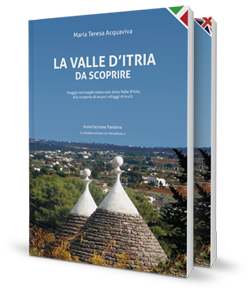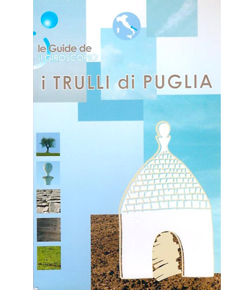Text translated by Google translate.
If you prefer charm and mystery in a trip a recommended destination is the Puglia countryside to discover, in the immediate hinterland, the megalithic monuments.
The journey to discover the megaliths is an adventure of the spirit immersed in centuries-old olive groves and wrapped in the chirping of cicadas. With steps on stony paths and red earth, every now and then the large stones better known as dolmen and menhir, bronze-age monuments built about 4000 years ago, appear. There were many destroyed, however, over the centuries of which traces and place names are preserved. Fortunately, some megaliths have survived and make us imagine the reality of an anthropological phenomenon linked to the cultural sphere of the communities that erected them, a phenomenon that spread so much in Puglia but that invested a wide geographical radius from Europe to Asia Minor and the north coast of Africa, in reference to similar megalithic monuments. Of course, in other forms megalithism has manifested itself in other parts of the world.
Dolmen is a term that comes from the Breton dialect, dol which means table and men that means stone. They are in fact formed by the juxtaposition of large stones from which the name of "megaliths" is born. Three, four or more slabs fixed vertically in the ground, ortostati, form a cell covered by a flat slab. From the dolmen with small cells to the most monumental with large cells preceded by an entrance corridor, the dromos, also once covered whose length varied from a few meters even to about ten meters.
Menhir are monolithic columns of varying height and shape, even of considerable size. The term menhir also comes from the Breton dialect and literally means long stone, composed of men, always stone, and hir which means long.
Why were the megaliths erected?
Literature varies on the use, meaning and function of the Puglian megaliths, and not only that, it varies.
The burial function attributed to the dolmen arises from the infrequent discovery of some skeletons. Precisely the small number of skeletons has suggested burials intended for the elite or only for the head of the communities, perhaps a priest. To that burial was also added a cult function of the dolmen deductible for example from the entrance usually facing east and the cell in which the deceased was laid in the west, respectively symbols of life and death. The passing of the millennia has seen the use of dolmen with different functions by many other communities that have succeeded in those places. Drains on the roofing plates of the cells suggest the use of dolmen with functions also of mas, so places where sacrifices of animals took place and blood was collected, perhaps propitiatory rites or rites of reception in the community of a foreigner. The hypotheses are many and suggestive.
Menhir have a phallic symbolism, therefore a function related to fertility rites, but they were also solar clocks because the wide facades of the single block are exposed to the east-west, along the trajectories of the sun, also here a clear reference to the birth and death and cyclicality of time.
Regardless of the functions shown so far, certainly these megalithic constructions have always been surrounded by a sense of mystery, so much so that the cult attached to them has continued well beyond their historical period. Suffice it to say that with the advent of Christianity, the Church worried about the cult of stones very deep rooted in rural populations, at first Christianized the megaliths, for example by having crosses engraved on the menhir, then came to destroy many. After the cults, legends and superstitions have singed around the great stones that have come to us.
The Dolmen of Montalbano
Speaking of legend, it is said that it was giants who raised large stones and that they erected the Dolmen of Montalbano, also known as La Tavola dei Paladini. But suggestions aside, things perhaps went differently, and it was simple prehistoric men who had honed techniques for moving mammoth stones. It is assumed that these monoliths rolled on wooden logs to the chosen place. Then the ortostati slipped into pre-excavated canals, and so they got the cell fence. The roofing slab was raised by dragging on slides attached to the ortostati, similar to ramps made of stone. At the inhumation of the deceased, the entire tomb was covered with stone until it formed a mound that concealed it from possible desecration.
The Dolmen is located in the Contrada Pescomarano, nestled in the Plain of secular Olive Trees in the center of Puglia, very close to the Contrada of Montalbano in the territory of Fasano, in the Parco Naturale delle Dune Costiere. Not far away you can visit the Lama Morelli, typical streamrow, a karst phenomenon very widespread on the Adriatic and Ionic coasts of Puglia, in whose seas are outlet the blades. The presence of a small trullo near of the Dolmen of Montalbano is a testament to the thousand-year-old relationship of man with stone in karst Puglia, a union that has bequeathed different monuments for ages and functions.
Currently the Dolmen of Montalbano, which is incomplete, is composed of three imposing slabs of local limestone that form a rectangular compartment with orientation along the northeast, southwest axis. The two side slabs, the ortostati, measure length 2.80 and height 1.55 with a thickness of 40 cm the one on the left, length cm 1.75 and height 1.40 with thickness of 30 cm the right orthotic. The internal distance between the two ortostati is 1.40 cm. The roof slab is 220 cm long and 200 cm wide, 30 cm thick. The structure was complemented by a dromos and a mound cover, both removed in the twentieth century by the owners of the fund who used the dolmen as a deposit. The Dolmen of Montalbano was therefore a Specchia Dolmenica, a megalith with burial functions covered with a mound of earth and stone. Many other Puglian megaliths belong to this category of specchie, that is, with funerary function, to be distinguished, however, from the other specchie scattered in the countryside, perhaps of the period of the mass or built in the Middle Ages with functions of turrets, and from the agricultural specchie much more recent.
The Dolmen of Montalbano is surrounded by other interesting archaeological evidence. A few meters away there is a cave, pit tombs dug in the rock bank and above all the Lama Morelli already mentioned, of interest not only morphological and naturalistic, but also anthropological for the traces of cave settlements.
An anecdote about the incessant use of some Puglian megaliths. The Dolmen of Montalbano in the twentieth century, when it had already been stripped from the mirror that contained it, was used not only as a storage for agricultural tools but also as a dog kennel of the owner of the fund. You could say a dog with a priceless home.
The dolmen, finally, for a long time was also reported to the territory of Cisternino, which is located at higher altitudes on the Murgia sud-est, further inland. The error arose because the archaeologist Michele Gervasio, who first studied the Dolmen in 1910, arrived at the place descending to the nearby Cisternino State Station, on the Adriatic route. Some text also reads Dolmen di Fasano.
Much of the information described on Megalitism in Puglia is taken from the graduation thesis work of the author of the article.
Of interest on the Dolmen of Montalbano is an essay written by Sabrina Del Piano and Michele Pastore entitled The Dolmen of Montalbano in Cisternino in the broad phenomenology of megalithism, in Humanism Reflections of the Stone - 2008.













